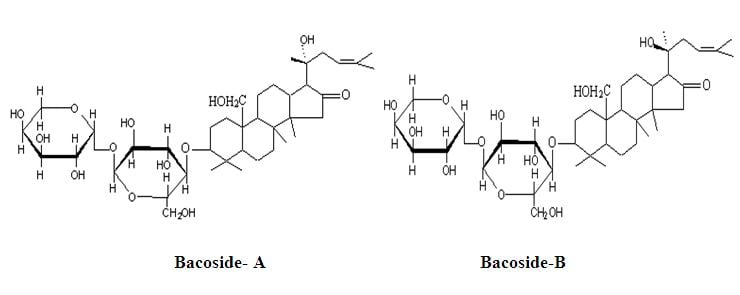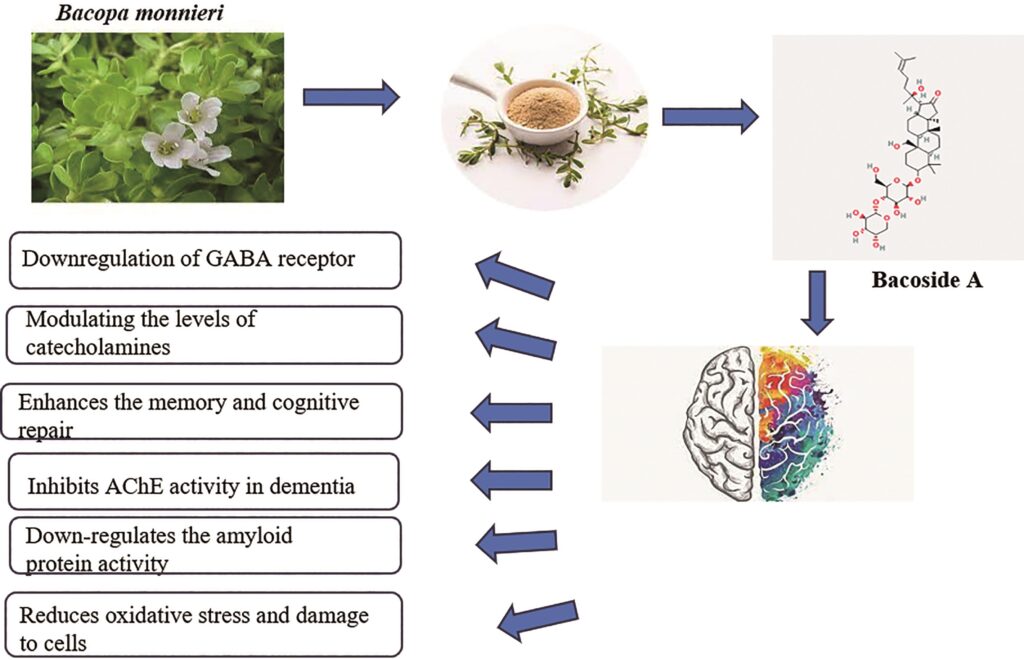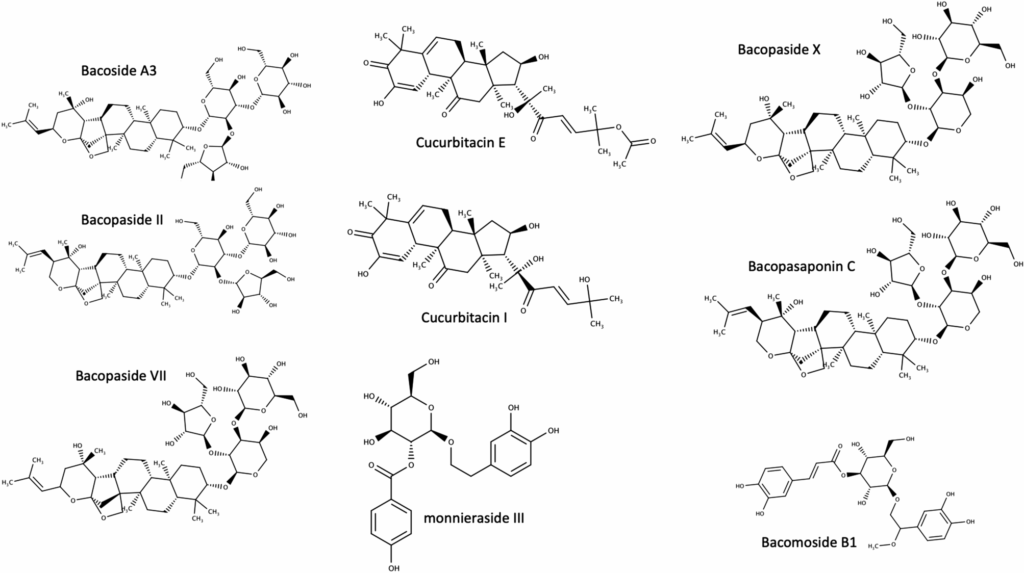
Bacopa monnieri, known as Brahmi in Ayurveda, has been celebrated for its brain-enhancing and neuroprotective properties.
Over the past few decades, modern pharmacological and clinical research has verified that its cognitive and adaptogenic benefits arise largely from a unique class of triterpenoid saponins called bacosides. Among these, the bacoside A and bacoside B fractions are the most investigated and form the biochemical foundation of Bacopa’s reputation as a potent herbal nootropic.
Understanding that product’s composition, mechanisms, and clinical relevance offers a deeper appreciation of how Bacopa extract supports cognition, attention, and neuroprotection in both healthy and aging minds.
Key Takeaways
- Bacoside A: Demonstrates strong evidence for enhancing memory, learning, and synaptic connectivity, validated by multiple clinical trials.
- Bacoside B: Provides complementary neuroprotective and antioxidant effects, reinforcing adaptive and cognitive stability.
- Synergy: Full-spectrum extracts containing both A and B fractions yield superior outcomes compared to single-component isolates.
- Standardization: Accurate analytical validation through HPLC ensures reproducible efficacy and distinguishes clinically reliable extracts from generic counterparts.
What Are Bacosides?

Bacosides are the primary active constituents of Bacopa monnieri extract, classified as dammarane-type triterpenoid saponins. These complex glycosides are not single molecules but rather families of structurally related compounds that collectively impart Bacopa’s pharmacological effects. The major identified members within these fractions include bacoside A3, bacopaside II, bacopaside X, bacopaside I, and bacopasaponin C, each contributing distinct yet complementary neuroprotective and antioxidant properties.
Traditionally, raw Bacopa powders or hydroalcoholic extracts showed significant variability in their saponin composition. However, with the advancement of analytical techniques and standardization, specific fractions like bacoside A and bacoside B have become biomarkers for extract quality and consistency. These fractions are now used to standardize clinically validated Bacopa extracts such as BACOMIND®.
Clinical and Pharmacological Significance of Bacoside A
Bacoside A is the most researched and pharmacodynamically active fraction of Bacopa monnieri extract. It is primarily associated with memory enhancement, learning ability, and synaptic plasticity. The pharmacological mechanisms identified in preclinical and human studies reveal several pathways through which this fraction prevents cognitive decline:
- Modulation of neurotransmission: Bacoside A enhances cholinergic transmission by maintaining healthy acetylcholine levels and increasing activity of choline acetyltransferase, vital for learning and memory.
- Neuroprotection: It reduces oxidative stress and lipid peroxidation, minimizes β-amyloid aggregation linked to Alzheimer’s disease, and inhibits neuronal apoptosis.
- Synaptic plasticity and neural architecture: It promotes dendritic branching and neuronal connectivity, suggesting long-term structural support for cognitive processing and memory storage.
Clinical trials involving Bacopa monnieri extract standardized for bacoside A have repeatedly demonstrated improvements in working memory, processing speed, delayed recall, and overall cognitive performance.
In healthy adults, supplementation for 8–12 weeks has shown measurable gains in visual information processing and learning capacity. In children diagnosed with attention deficit hyperactivity disorder (ADHD), bacoside A–rich extracts contributed to reductions in inattention, impulsivity, and restlessness, suggesting mechanisms involving enhanced dopaminergic and cholinergic regulation.
Preclinical data also emphasize that bacoside A aids the upregulation of antioxidant enzymes such as superoxide dismutase (SOD), catalase, and glutathione peroxidase, reflecting its multifaceted action profile: part neurotransmitter modulator, part antioxidant, and part neuronal architect.
Role and Complementary Function of Bacoside B

While bacoside A often receives the spotlight, bacoside B plays an equally important though less individually studied role.
Chemically, it is considered a stereoisomeric counterpart to bacoside A, differing slightly in spatial configuration but sharing similar saponin backbones. Earlier thin-layer chromatography (TLC) and HPTLC studies often found the two fractions co-eluting, suggesting remarkable structural similarity.
Functionally, bacoside B demonstrates:
- Antioxidant properties: It participates in scavenging free radicals and stabilizing neuronal membranes under oxidative stress.
- Adaptogenic and anti-stress effects: Animal studies indicate that bacoside B supports stress resilience by balancing cortisol and improving cellular energy metabolism.
- Synaptic resilience: It may assist in maintaining the structural integrity of synaptic proteins, complementing bacoside A’s functional enhancement of neurotransmission.
Although isolated human studies exclusively on bacoside B remain limited, most researchers consider it an integral part of the synergistic efficacy of full-spectrum Bacopa extracts. It supports and amplifies the cognitive and neuroprotective effects initiated by bacoside A, contributing to the holistic adaptogenic nature of the herb.
Synergistic Spectrum: Why Both Fractions Matter

Bacopa’s efficacy cannot be reduced to a single molecule. The combined presence of bacoside A, bacoside B, and minor saponins creates a polypharmacological effect, a hallmark of herbal nootropics. This synergy influences multiple neurochemical pathways simultaneously, aligning with the Ayurvedic principle that the whole herb acts better than its parts.
Together, bacoside A and B support:
- Memory and concentration enhancement through cholinergic and serotonergic facilitation.
- Neuroprotection against oxidative damage.
- Stress mitigation via adaptogenic pathways.
- Long-term structural support through protein and enzyme stabilization.
Thus, rather than relying on isolated chemical activity, Bacopa’s cognitive benefits emerge from the coordinated interplay of these saponin families within standardized extracts.
Clinical Evidence Linking Bacoside Fractions to Cognitive Benefits
Memory and Cognition in Adults:
Multiple double-blind, placebo-controlled studies on standardized Bacopa extracts rich in bacoside A and B show significant improvement in delayed recall, attention span, and cognitive processing speed. These benefits typically appear after 8–12 weeks of consistent supplementation, aligning with the time needed for neuronal remodeling and dendritic branching identified in animal models.
ADHD in Children:
Bacopa extracts standardized to bacosides have demonstrated clear clinical efficacy in children with ADHD, reducing restlessness and improving attention. The effects are attributed primarily to bacoside A’s modulation of neural signaling, with bacoside B supporting neuronal stabilization and antioxidant protection.
Neuroprotection and Healthy Aging:
In experimental aging models, both bacoside A and B have shown reduction of oxidative markers and preservation of brain antioxidant enzymes. This points toward potential applications in age-related cognitive decline and early-stage neurodegenerative disorders.
The Standardization Challenge and Analytical Precision
A significant concern in the global Bacopa market is the lack of precision in standardization. Many commercial extracts claim to contain a high percentage of “total bacosides” measured by UV spectrophotometry, which often includes non-specific saponins, leading to inflated values. However, such methods fail to differentiate between bacoside A, bacoside B, and unrelated glycosides.
In contrast, clinically validated extracts such as Natural Remedies BACOMIND®, employ advanced chromatographic techniques like HPLC for precise quantification and profiling. These methods ensure reproducible ratios of the A and B fractions, preserving the extract’s clinical fingerprint and guaranteeing correlation with published efficacy data. True scientific leadership in Bacopa research thus lies in maintaining the natural spectrum of bioactives with rigorous reproducibility rather than pursuing artificially elevated “% bacosides” numbers.
Conclusion
Ultimately, bacopa monnieri extract reputation as a clinically substantiated herbal nootropic rests not on isolated chemical claims but on a harmonized synergy between bacoside A and bacoside B, two mirror-like saponin fractions working together to support clarity, recall, and cognitive vitality across the lifespan.
FAQs
1. What are the key health benefits of Bacopa monnieri extract?
Bacopa monnieri extract supports cognitive health by enhancing memory, learning, and resilience of the nervous system. Its bioactive compounds, particularly bacosides A and B, protect the central nervous system, combat cognitive decline, and promote the healthy functioning of parts of the brain. Clinical studies also show its adaptogenic effects help reduce stress-related health issues.
2. How do bacosides support memory and brain function?
Bacoside A and B are the primary active components of Bacopa monnieri extract known to enhance neurotransmission, support synaptic plasticity, and protect against oxidative damage. These actions collectively improve memory retention, learning ability, and the performance of parts of the brain and their functions, making bacosides crucial in formulations targeting memory loss.
3. Can Bacopa extracts help with focus and attention in children and adults?
Yes, clinical studies on bacopa extract, especially those standardized for bacoside A and B, show significant improvements in attention, focus, and impulse control in both adults and children, including those with ADHD. These benefits stem from enhanced communication in the central nervous system and regulation of key neurotransmitters involved in attention and alertness.
4. Why are some Bacopa supplements more effective than others?
The efficacy of Bacopa monnieri extract depends on its standardization and the accuracy of its bacoside content. Products using full-spectrum extracts with clinically validated levels of bacoside A and B, such as BACOMIND®, ensure bioavailability and reproducibility. In contrast, poorly standardized supplements may contain non-specific saponins, reducing impact on nervous system health and cognitive decline.
5. What should I look for when choosing a high-quality Bacopa extract?
Choose a Bacopa extract that is standardized using advanced methods like HPLC or LC-MS to ensure accurate levels of bacoside A and B. Look for clinical validation and transparency in composition. High-quality extracts maintain the full spectrum of bioactives needed to support parts of the brain and their functions, offering real efficacy for medicine for memory loss and nervous system support.
